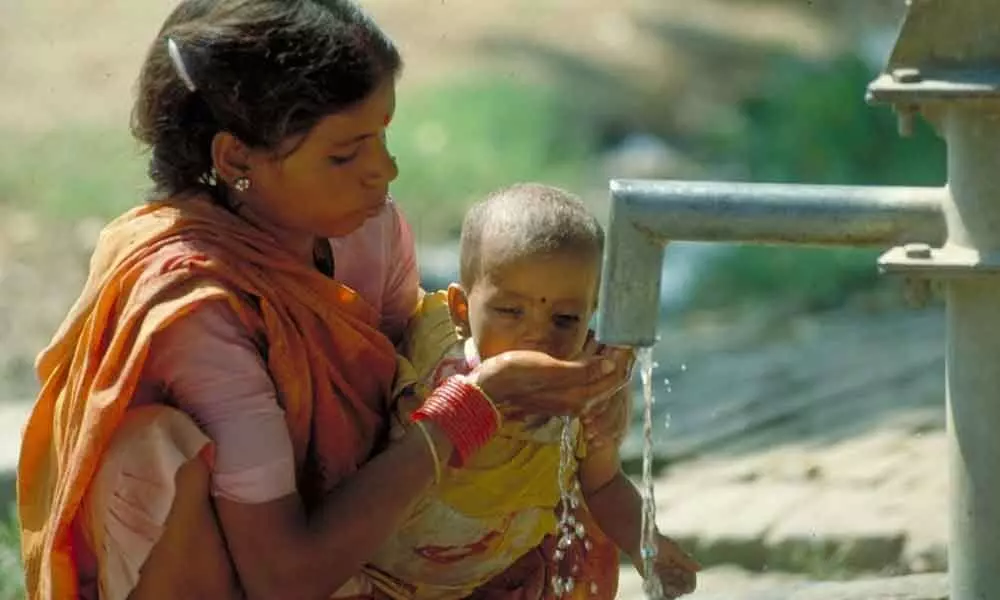Teenage pregnancies and motherhood in Telangana

Teenage pregnancies and motherhood in Telangana
Teenage pregnancies and childbirth are perhaps two important issues concerned with gender and well-being, which has been widely discussed and debated in India in general and Telangana in particular
Teenage pregnancies and childbirth are perhaps two important issues concerned with gender and well-being, which has been widely discussed and debated in India in general and Telangana in particular. The issue of teenage pregnancies, motherhood and its impact in the State of Telangana is examined based on the recent data released for the 5th round survey (2019-20) of the National Family Health Survey (NFHS - 5).
As per NFHS - 5, women aged 15-19 years who were already mother or pregnant at the time of survey in Telangana were 5.8 per cent. This issue is more prevalent in the rural areas (7.4 per cent) than in urban areas (3.1per cent). Districts in Telangana like Nalgonda, Suryapet, Jangaon, Medak, Mahabubabad, Karimnagar, Adilabad, Mahbubnagar, Nirmal, Vikarabad, Khamam, Warangal Rural, Bhadradri Kothagudem, Jayashankar Bhupalpally and Jogulamba Gadwal had a higher percentage than the State average. As per the data, the district with the highest number of women in this category is Jogulamba Gadwal with 15.9 per cent, followed by Jayashankar Bhupalpally with 13.2 per cent whereas Siddipet had the lowest percentage with 1.0 per cent.
In a patriarchal setting, the society visualises the sexuality of a teenage girl as problematic. Men do not face much taboo and restrain as far as their exercise of sexual autonomy is concerned. Most of the times, lack of knowledge about sex and sexuality may lead to teenagers being involved in the sexual activities that lead to pregnancies and many a times unsafe abortions.
Child marriage is the direct outcome of the societal pressure regarding control over women's sexual autonomy. The most serious impact of an early marriage is early pregnancy. According to NFHS - 5, 23.5 per cent of the women aged 20-24 years were married before the age of 18 years in Telangana (more prevalent in rural areas with 27.4 per cent), with a decline from 26.2 per cent in NFHS - 4 (2015-16).
Districts like Nizamabad, Jayashankar Bhupalpally, Komaram Bheem Asifabad, Nalgonda, Mahabubabad, Jagitial, Ranga Reddy, Suryapet, Sangareddy, Kamareddy, Medak, Nagarkurnool, Wanaparthy, Jogulamba Gadwal, Khammam and Vikarabad had a higher percentage than the State average and the district with the highest number of women in this category is Vikarabad with 39.8 per cent, followed by Khammam with 35.0 per cent and Jogulamba Gadwal with 34.6 per cent whereas Medchal-Malkajgiri had the lowest percentage with 10.2 per cent.
Schemes like Kalyana Lakshmi and Shadi Mubarak sponsored by the Telangana government could have attributed to parents' decision to postpone the marriage of their daughters until they attain 18 years. Implementation of these schemes may be one of the reasons for the decline in the number of women aged 20-24 years getting married before the age of 18 years in Telangana and for the overall increase in their age at marriage.
However, the pace of change has been slow despite such measures made by the government as these attempts have not had the desired effect of significantly reducing the number of women from this cohort.
Knowledge about family planning methods has a direct bearing with pregnancy/motherhood, which is the main deciding indicator of the health and wellbeing of a woman. The awareness level of the people regarding this aspect has been increasing over a period of time. As per NFHS - 5, 66.7 per cent of the currently married women aged 15-49 years are not using any modern method of family planning. There is an approximate 10 per cent increase in such usage in comparison with the levels under NFHS - 4.
Sterilisation method has emerged as one of the important family planning technique, which people popularly adopt but the main target for the same is largely the woman from the husband-wife pair. This is evident from the data wherein there has been no incidence of male sterilisation reported in the districts like Hyderabad, Jogulamba Gadwal, Mahbubnagar, Nagarkurnool, Nalgonda, Nizamabad, Vikarabad and Wanaparthy whereas the share is less than 1 per cent in districts like Kamareddy, Ranga Reddy, Yadadri Bhuvanagiri, Komaram Bheem Asifabad, Medak, Nirmal, Sangareddy, Khammam, Suryapet, Mancherial, Adilabad, Medchal-Malkajgiri and Siddipet. Even the lowest share of female sterilisation stood at 44.4 per cent (Karimnagar district). Thus, the need of the hour is to strengthen the awareness regarding the benefit and impact of sterilisation process irrespective of gender so that more numbers of men would also participate in this process.
Several policies, programmes and schemes have focused on improved institutional and infrastructural investments to improve maternal well-being. In Telangana, there is a sharp increase observed in the institutional births in public facility – from 30.5 per cent in NFHS - 4 to 49.7 per cent in NFHS - 5.
A cash incentive of Rs 12,000 (and additional Rs 1000, if the newborn is a girl child) by the Telangana government is provided to women who deliver their babies in government hospitals. Besides this, KCR Kit (health and sanitary bag) is a very important welfare scheme related to safe motherhood. Cumulatively, it is motivating the rural pregnant women to opt for government hospitals and health centres.
Apart from this, another important indicator related to pregnancy and motherhood is adolescent fertility rate for women age 15-19 year, which is expressed in terms of births per 1,000 women age 15-19 years. In this indicator too, a sharp decline has been observed from 67 in NFHS - 4 to 48 in NFHS - 5.
The sustenance of such indicators and relevant programmes needs provision of additional hands at grassroots level in terms of health personnel to provide health support. The report on Rural Health Statistics of National Health Mission 2018-19 published by the government of India in 2019 indicates that total number of specialists (surgeon, physician, gynaecologist and paediatrician) at community health centres (CHCs) in rural areas are 258 against sanctioned position of 625; 647 laboratory technicians in primary health centres (PHCs) and CHCs at rural areas against sanctioned position of 773; 442 number of pharmacists at PHCs and CHCs in rural areas against sanctioned position of 675; and 44 radiographers at CHCs in rural areas against sanctioned position of 99.
Coordination and monitoring of the institutional and infrastructural investments already made by the government of Telangana along with sustained efforts to bridge these gaps will lead to greater health wellbeing of the people of Telangana.
(The author is Professor (Economics), Council for Social Development, ICSSR, Rajendranagar, Hyderabad)
















